Part 2 of the Rhône Series. 12,000 years ago, glaciers melted; ice and water were pushed down south; river rocks were deposited 20 km wide, and Châteaunuef-du-Pape was born.
Much can be said about the history, the vines, the terrior and the vines of Châteaunuef-du-Pape. For those who have visited one of France greatest vineyards, they would empathise with me when I say that treading through the vineyards of CDP is not fun. The soil is laden with huge galets (stony rounded pebbles) that are the size of one’s fist or bigger. One cannot imagine how anything can thrive in such harsh terrains.
To understand the hardiness of grape vines, one must pay pilgrimage and see the land for themselves. It is difficult to comprehend how pickers during the harvest can survive the day. With thousands of pebbles strewn everywhere, the vineyard grounds are uneven. Losing your footing and scrapping yourself on one of these giant pebbles can happen to anyone which is the reason many seasoned pickers wear proper boots. Moreover, during the summer, not only does one gets the full blast of the Rhône’s sun, but the rocks themselves radiate the heat back to give what I call the microwave effect. This helps keep the vines warm and prevent frost damage. But as many would say, the worst soils make the best wines and I would tread these lands just to have a taste of Châteaunuef-du-Pape.
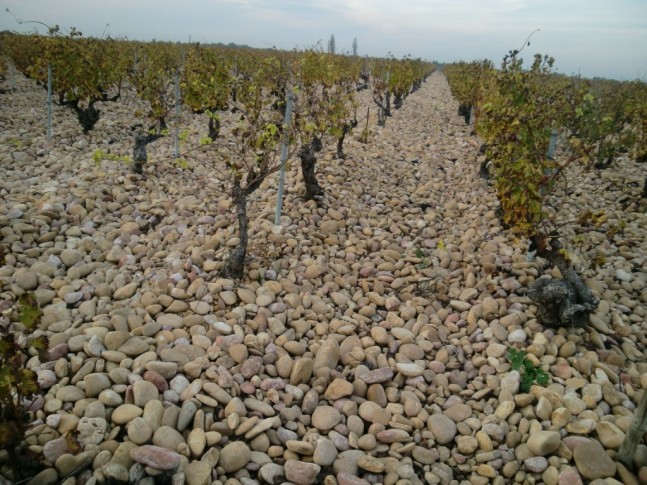
The terrior of Châteaunuef-du-Pape
A Short History
Translated as the pope’s new castle, the history of the region is as rich as its wines. The origins of the appellation’s name goes back to 1308, when Pope Clement V, then Archbishop of Bordeaux, decided to re-locate the papacy to Avignon and Châteaunuef-du-Pape was selected to be his summer home. Had it not been for this decision, the wines of CDP would never have gotten the limelight that it has today. When John XXII succeeded Clement V, much effort was put into improving the viticulture practices. The Pope, having decided that he deserved to be drinking only good stuff, helped raise the quality standards. Centuries later, Bordeaux begin using the wines of the south to add colour to their wines in bad vintages. Thus, the Co-operatives in the Rhône started charging them for the price of the wine.
Although seven successive Popes help established CDP as an illustrious wine region, it was the Baron Pierre Le Roy de Boiseaumarie who played an important role in putting CDP on the world map as an Appellation Contrôlée. It was the Baron himself who co-founded the Institut National des Appellations d’Origine (INAO) which is the body responsible for the formation of the Appellation System of France.
To combat fraud, Baron Le Roy drafted up production rules for CDP such as yields, grape varieties, and winemaking techniques in 1923. This would subsequently serve as a prototype for future AOC rules. In 1936, Châteaunuef-du-Pape officially became France’s first AOC along with Tavel. The Baron was the president of the INAO for 20 years. The need to combat fraud instilled a sense of protectionism of their terrior in the vignerons of CDP. This attitude even lead to the passing of a municipal decree in 1954 that prohibited the landing, taking off and overhead flying of flying saucers in CDP. This has inspired winemaker, Randall Grahm of Bonny Doon vineyards to name one of his wines, Le Cigare Volant (the flying cigar). The Californian wine is made with CDP grapes and pays homage to it.
The Land
The A7 and A9 highways go around the boundaries of the CDP’s vineyards and across the N7 highway near Orange, the appellation becomes Côte du Rhône, although the soils are quite similar. CDP has an elevation of 25 to 130 meters. Being a low land on an ancient riverbed, the grapes here are the first to be harvested in late August – 2 weeks before Gigondas and Vacqueyras.
The land is littered with siliceous (Silex) pebbles in the form of bright yellow stones. The silex and large rocks of CDP go 2 to 2.5 meters deep before hitting variations of red sandstone and limestone-clay soils. 6000 years ago, the stones used to be 6 metre higher before the silex grinded the softer stones into small pebbles. Sandy soils are the youngest deposits of the Rhône River.One of the unique properties of the land is how the stones absorb heat from the sun and radiate heat back onto the grapes at night. Although Syrah is grown here, the amount of sun shine and heat does not produce elegant versions of it. Day time temperatures can go from 40 to 45° Celsius in the summer and 55° Celsius on the skin of the grapes.
There is a tendency for floods to happen in the region. When it rains, it is usually within a short period of time throughout the year. With the strong mistral winds blowing away insects and alleviating disease pressures by drying out the grapes, it is easy to convert to organic farming.The mistral wind coming from the Alps helps to bring down the temperatures during summers of extreme heat. The winds can travel from 130 to 250 km/hour (as measured from Mt Ventoux) and is present for 100 days in a year. It is the strongest between noon and 3 pm. If you came in January, you would find the wind cutting through your bones. The wind breaks 2-5% of the branches which is why the goblet method is used on the vines.
It is the wind which contributes to the ripeness of the grapes, assisting to break down the cell walls, making the skin fragile so that the ripe flavours can develop. This also evaporates the juice from the grapes and concentrates the flavours. The sun also aids in concentratingflavours, sugar and acid in the grapes through dehydration. This is the same effect that the sun has on Tinta Barroca grapes in Portugal.
Unlike Provence, where grapes need not be ripe to produce rosé, phenolic ripeness is vital in the Rhône for colour. To tell if the grapes are ripe, squeeze the grapes and if the seeds come out easily without any of the flesh around it, that is a good sign. Next, if the seeds are brown instead of green, taste the seed. Nuttiness is a sign of ripeness. The skin is about 3% of the grape but the flavours and colour are contained in the skins. With good ripeness, there is ease of colour extraction during the ferments. Harvesting is usually done in small bins along with berry selection.
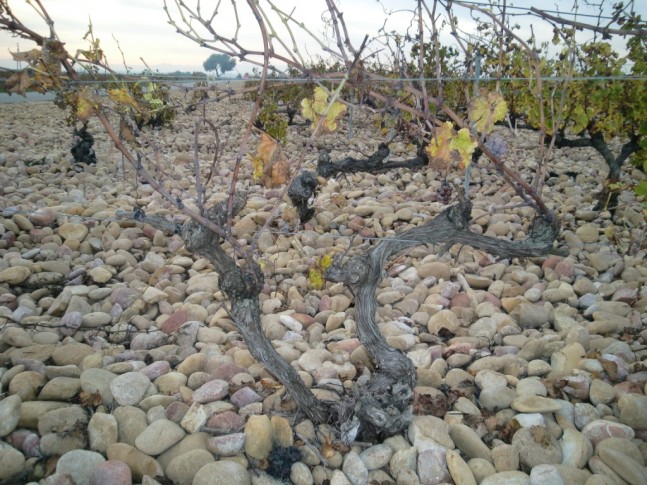
The old vines of Châteaunuef-du-Pape among the stony silex pebbles
The Grapes & the Vines
Châteaunuef-du-Pape has a total of 3164 hectares with basic yields of 33hl/hectare shared among 350 producers. The region produces both reds and whites with at least 12.5% of alcohol after ferment. With 2800 hours of sunshine in the region, this minimum is usually exceeded. No chaptalisation is permitted and any acid additions must be declared. The vines are all grown on US root stock.
Most of the literature states that Châteaunuef-du-Pape is made from 13 grapes. If you were to consider the mutations of piquepoul (Blanc&Gris), clairette (rose) and Grenache (Blanc&Gris), this would be a total of 18 grapes. The main grapes used are Grenache, Cinsault, Mourvèdre and Syrah for the reds. Most domains use at least 50% of Grenache. Grenache is used in the blend to provide the lifted sweet and jammy aromas. Syrah is added in bad years for colour and spice while Mourvèdre is used to give structure, tannins and ageability to the blend. For the whites, most producers use Grenache Blanc and Roussanne. Château de Beaucastel is the only one that I know which uses all the grape varietals in their red wines and makes a 100% Roussanne for one of their range of whites.
Most of the reds are planted on the silex soil while the whites are planted on the sandy part. Sandy soil has a tendency to make fruity wines with less tannin. The sandy soils, containing quartz, also have fewer vibrations to produce heat, causing the tannins to be gentler and the vine to have less chrophyll activity. The rockier soils produce more tannin which is better for the reds.
Guyot pruning is done for the Syrah while for the other grape varieties, goblet or bush vines are being used. Wires and stakes are not permitted but trellis is allowed for Syrah. This is because Syrah has more fruit at the end of the canes and needs the trellis support. For vines like Grenache, the fruit is more at the trunk and can be trained goblet style. The allowed limits are 2.5 tons/ acre. All the grapes are hand-picked. In the harvest, the good grapes are selected and the bad ones are used to make Vin de Table. It is part of the law that 5% of harvest is rejected during the sorting of the grapes.
From 1910 to 1920, the vines used to be planted 6.5 ft apart x 7 ft row for the horses. Today, this has changed to 1 m x 1m spacings. Higher densities are encouraged now for stressing the vines. According to organic practices, weeds are left in the middle. The vines are being replaced yearly and it is obligatory to have a certain percentage of old vines. If there is less than 10% of the old vines (60-100 years old)in a vineyard, the AOC would be considered a Côte du Rhône.
In the winter, machines would plow the grass and carry out buttage to protect the vines against frost but in most parts of Rhône, frost is not common. In spring, the inverse is done and compost is put into the earth.
The Pope’s Bottle
Embossed on the red and white bottles are the Papal regalia and insignia – the tiara of the pope with two keys of Saint Peter below the tiara crossing each other. Only bottles from CDP can carry the symbols on the bottle. The bottle was created in 1937 by the Baron Le Roy. To be able to use the bottles, a producer had to be a member of La Fédération des Syndicats de Producteurs de Châteauneuf du Pape. Members of the federation had to pay 1 to 2 Euros for each bottle in order to market their wines as being from CDP. Years later, some the members decided not to pay for the bottles and disputed the use of the bottle in court.
Another organization of wine growers called the Syndicat Intercommunal de Défence Viticole de l’Appellation d’Origine Contrôlée Châteauneuf-du-Pape(SIDVAOC), which was created back in 1960, came up with another bottle with the bishop’s hat, no keys, and the words CDP embossed on the bottle. Today, producers such as Mont-Redon use it instead of the federation’s bottle. The different insignias on the bottle are to give a label of authority from the different wine organisations. The dispute also lead to other producers creating their own bottle such as Château de Beaucastel and Pere Anselme. Others like Château Rayas do not have any insignia. The negociants are not permitted to use the same bottles so they usually use another insignia that has the words CDP AOC written in a circle with the pope’s tiara and keys in the center of the circle.
Drinking le Vin de Pope
CDP is one of those peculiar wines like Barolo and Barbaresco in terms of colour. There is a tendency for CDP reds to lose its dark purple colour in its 4th year.
With the reds, you would expect CDP to be able to age like a Bordeaux wine for many years but it does not have the same longeavity as Bordeaux. This is due to a high percentage of the blends containing predominantly Grenache. Grenache, which I have mentioned in my first part of the Rhône series, is delicate and can be easily oxidized. This is why winemakers tend to minimize the movement of Grenache juice and use big barrels during the aging to reduce the amount of oxygen transferred.
2-5 years is considered to be a young CDP while 10-11 years is considered aged. CDP has a tendency to enter a dumb phase after 5-6 years. It starts to closes up, sometimes permanently. The only way to be safe that it will express itself again is to wait for about another 5 more years – a total of ten years from vintage. I have learned that the bigger the nose of the wine, the more time is needed for the wine to find its balance. According to my guide, Mike Rijken, the CDP 05 is a big and beautiful wine but after 6 months, it started to close down on the nose, and it was all tannic with little aromas. When I asked Mike if there was any reason to this peculiar nature of CDP wines shutting down and opening up again according to the estimated number of years, he responded, “Patience has its reason, but the reason does not know why.”
With food, red CDP pairs beautifully with a large range of dishes like barbecued pork, Chinese food, and dishes with lots of herbs, even mushroom dishes. There is something about CDP that taste reminiscent of the spices and ingredients back in Asia which I think has something to do with the oxidative characteristics of Grenache. Grenache goes very well with Asian food. The oxidised flavours of Grenache give me an impression of soy, hair moss and Chinese herbs. At 3000 tons/ha, Grenache has concentrated flavours and the alcohol of the wine is not dominant.
The whites themselves work beautiful with the Asian-influenced dishes or dishes with an umami focus like miso soup, moules frites, and dishes with coriander or fennel. CDP white contains a lot of exotic characters like nuts, anise, grapefruit, and mandarins.
Mike, who worked at Château de Beaucastel, loves his Beaucastel served at 13 to 14° as the wines usually warm up much faster by 1-2° in the summer.
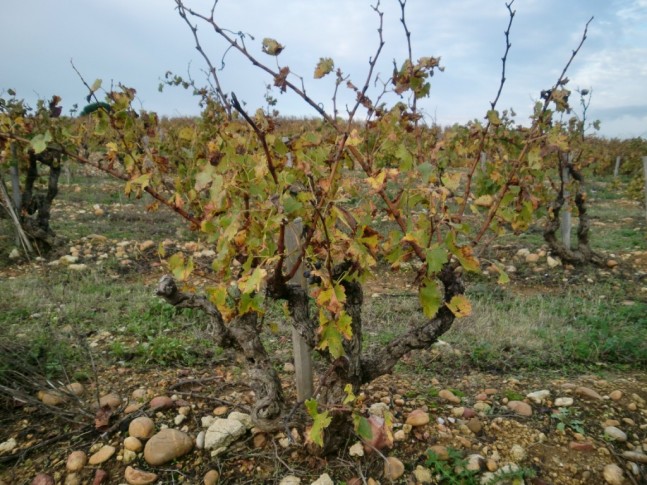
The vines of le pointu
Domaine le Pointu
Domaine le Pointu is an underdog of the region and is being run by Karine and Patrick Coste. They own 8 hectares of CDP on rocky and sandy soil for different vineyards. The domaine uses organic farming. Ferments for their redstakes place in whole-bunches in old barrels. To do this, the Grenache has to be super ripe and has to be done in small volumes so that the temperature does not get too high to destroy the aromatics. Temperatures are regulated at 25 to 27°Celsius through small volumes. The grapes under-go semi-carbonic maceration in the oak barrels and are left in the open. Concrete fermenters are also used as with the thick walls, there are small temperature variations and the walls are slightly porous which allows small amounts of oxidation. Stainless steel is not used as the domaine feels that there is too much lees movement in the tanks due to electrostatic phenomenon. Pumping over and pigeage are not done here as the domaine wishes to avoid too much movement that would potentially oxidise the delicate aromas of the Grenache.
The Domaine’s Côte du Rhône (CDR) wines are all tank aged except for the cuvee le vieux chêne. Their CDP are also tank aged except for their cuvees. The domaine produces 2500 hl of wines which roughly translates to 200 000 bottles per year for them.
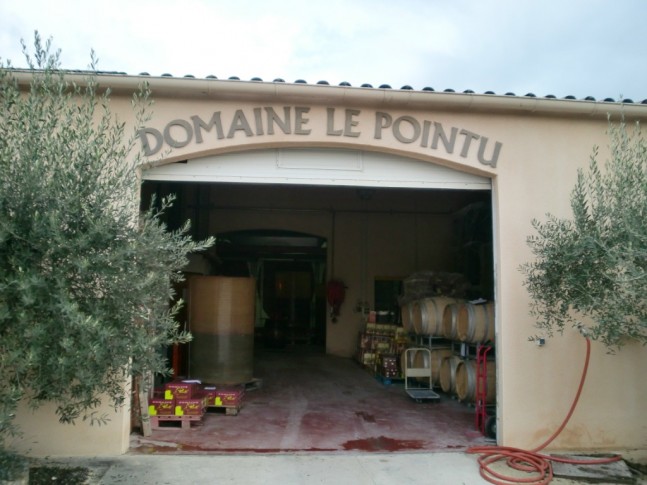
The cellars of Domaine le Pointu
Cuvée le vieux chêne (White) 2009, White Grenache & Clairette, 13.5%, Côte du Rhône
Pale yellow appearance. The nose is vinous, leesy aroma, medium(+) intensity, warm and buttery smell, light honey. On the palate, high acid, rounded, leesy, nutty flavours, long length, nutty finish.
There is a sort of fatness/umami to the wine. A sort of oxidized style but it is not acetaldehyde. The juice is fermented in small barrels and the juice is pressed before ferment. 9 months in oak and no MLF but aged on fine lees. This wine has not been racked as Grenache is prone to oxidation. The Grenache gives fatness and the clairette imparts freshness of acidity.
Côte du Rhône (Red) 2006, 80-85% Grenache, Cinsault, Syrah, Mourvèdre, 14%, €6
Orange colour. The nose is developed, earthy, mushroom, rhubarb. On the palate, medium acid and tannin, soft texture, earth, chocolate, mushroom, med(+) length, soy finish. For the style, taste like Chinese herbs but could use some oak to round off the edges. Aged solely in tank.
Cuvée le vieux chêne (Red) 2006, 80-85% Grenache, Cinsault, Syrah, Mourvèdre, 14%, Côte du Rhône
Orange colour. The nose is developing, earth, mushroom, light vanilla, sunbaked fruit, med(+) intensity. On the palate, medium acid, vanilla, light nail varnish, med(+) tannins, chalky texture, long length, Chinese herbs and spice, cinnamon stick.
12 months in old small barrels.
CDP (Red) 2006, 15%, €28
Semi-opaque orange colour. Developed nose, soy, hair moss, earth, seaweed. On the palate, med(+) acid, dates, dried plums, seaweed, earth, moss, med(+) tannins, grainy texture, med length, soy, bay leaves, cloves.
Cuvée Mathieu (Red), 2007, Grenache & Cinsault,15%, CDP, €40
Semi-opaque orange colour. Nose of soy, bay leaves, seaweed, mushrooms, developing, plums, hair moss. On the palate, med(+) tannins, powdery texture, concentrated, spices, long length, beautiful cedar flavours in the back, mushroom, red plums, complex.
More sandy soils, 90-105 year old vines, 35 hl/ha yields. The grapes are vinified separately and fermentation occurs in concrete tanks and aged in French oak.
Cuvée Cléments (Red), 2006, Grenache & Cinsault, 15%, CDP
Semi-opaque garnet colour. The nose is vanilla, peppery, light jam, spice, and leather, developed. On the palate, cedar, granite, med(+) tannins, grainy grating texture, lots of rock flavours, med(+) acid, long length, chocolate, a thickness to it, dark soy sauce in the back, earthy back palate.
95% Granitic soils and the rest are rocks, 90-105 year old vines, 35 hl/ha yields. The grapes are vinified separately and fermentation occurs in concrete tanks and aged in French oak.
Feuilles d’Or, 2009, White Grenache and Clairette, 14%, CDP, €30
Green colour. Med intensity on the nose, coconuts, nuts, banana. On the palate, high acid, med(+) alcohol, vinous, straw, med(-) length, smoky finish.
This vineyard is next to Rayas. Ferments in the barrel for 12 months, no MLF. 2500 bottles produced.
*Feuilles d’Or, 2008, White Grenache and Clairette, 14%, CDP
Pale green colour. Nose of banana, light popcorn, lollis, med(+) intensity, sweet vanilla. On the palate, high acid, med(+) alcohol, very good wine, long length, light nuttiness, citrus, grapefruit, a sweet vanillin spice to it, very unique finish, a light toastiness.
*Feuilles d’Or, 2007, White Grenache and Clairette, 14%, CDP
Pale yellow. Med(+) intensity, grapefruit nose, a complex oxidised aroma, light butter, a fatness to it, cold tea, nuts, mandarin. Palate is grapefruit, citrus, pomelo, nuttiness, high acid, med(+) alch, grapefruit, long length, complex nuttiness.
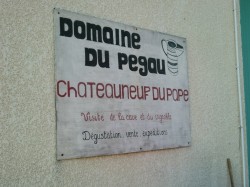
Welcome to Pegau
Domaine du Pegau
It was a real pleasure and a treat for me to be able to visit Laurence of Domaine Pegau, one of my favourite CDP producers. Laurence, who is the winemaker, started making wines in 1987. The domaine owns 20 hectares of red and 1 hectare of white. Some of the soils of her new vineyards are on clay soils. Laurence own 4.5 hectares of Mont Pertuis which are on south-facing slopes on red clay, stand and stone. Shealso owns 4 hectares of the famous vineyard, La Crau (sandy soil), which Domaine du Vieux Télégraphe has large holdings. Another 3 hectares of Grenache are planted on stony soils. The grapes on clay are fruity are being picked first.The grapes, which have more power and are darker coloured, on the stony soil are last to be picked. The grapes are all handpicked, co-planted and co-fermented. The proportions of her plantings are 60% clairette, 20% Grenache, 5.5% Rousanne, 5% Bourboulenc and the rest other grapes.
Weed killers are not used in the vineyard. The domaine is not officially organic or biodynamic. Spanish rabbits are a problem in her vineyard as they eat the vines and are disease resistant.
We spoke about her past and present vintages of CDP. According to her, 94 and 96 had high acidity, 2002 was a difficult vintage but the wines turned out well. In 2003, the stems were dry and overripe.2005 was an exceptional year. 2008 was a good vintage too and will age well but it is not like 2005. 2009 created a traditional style and no rackings were done during the élevage. 2010 was very pure and straight-forward. As for the 2011 vintage, the temperatures of the grapes brought in were high so the vats could not be filled up fully. Fresh grapes that came in daily had to be added to cool down the must. Temperatures of the ferment went up to 35° Celsius. There were no green flavours as the stems were not left long in the vats.
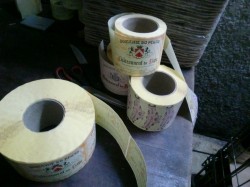
There is much labelling to be done today
This year, the white grapes went into stainless steel tanks with temperature control of 20 °Celsius. cooling jackets are used to cool tanks down. Cold water of 16°was sometimes drawn from the well to cool the ferment down. 1800 bottles of the white are produced. We tasted the 2011 from the steel vat. It shows signs of reduction and slight fusel oil aromas which is a good sign of protective handling. On the palate was good fresh acid, guava, passion fruit, slight MLF characters, nuttiness and a complex long length.
Citric and tartaric acid are used to prop up the acid and sulphur is added before ferment. The reds are wild-fermented in concrete vats without temperature control. The must goes through full-bunch ferments with a total of 10 days of maceration. Pump-over takes place 2 times a day. Pressing is done after 10 days and the pressed juice goes back into the cement vats.
Before, the reds were racked twice but now this has been reduced. Pumping or racking is not used because sulphites have to be added to protect the wine from oxygen. If the barrels smell of reduction, the wines are pumped out of barrel and back into it again after it is cleaned. Slovakian oak is used for the élevage. The reserve wines spend 2 years in barrels and no new oak is used. After blending the reserve wines in vats, the wines are bottled by gravity. 85000 bottles of the reserve are made. From the remaining blend, the wines are used for the Cuvée Laurence by extra aging. The aging for the Cuvée Laurence is 3 to 4 years in total. 4000 to 8000 bottles of the Laurence are made. The wines are usually released in the beginning of November.
The whites are filtered through cellulose but not the reds. Egg whites in powder form, casein and bentonite are used for fining. Laurence does carry out analyse on the wines throughout the wine’s time in the cellars except before ferment. 90% of her wines are exported to 30 countries.
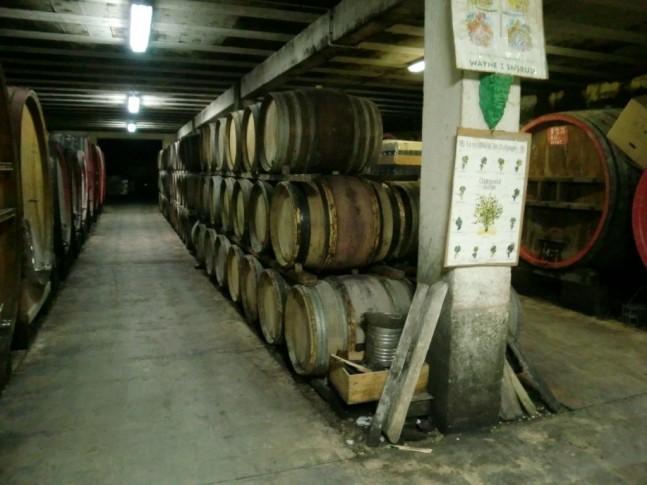
The chais of Domaine du Pegau
Plan Pegau, NV but consist from 2007 to 2010, 13.5%
A: deep purple colour. Nose of lacquered fruit, med(+) intensity, ripe cherries, bright strawberries, gammy, ink, caramel. On the palate, med(+) acid and tannins, juicy, sweet fruit of strawberry and jam, lots of dark cherries, blood plums, long length, red mulberries, red currants, lingering fruit.
Pegau 2008, 80% Grenache, 12% Syrah, 4% Mondeuse, 14%, €30
Ruby colour. Med(+) intensity, spice, floral, cherries, full blown expressive. The palate is med(+) acid, black tea, bright cherries, sweet liquorice, long length, med(+) tannins, chalky texture, huge burst of flavours in the back.
20000 bottles made.
*Pegau 2009, 14%, €35
Opaque purple. Floral nose, med(+) acid, high concentration, spices, overripe jam, strawberry, sweet liquorice, a sort of leather flavour to it. On the palate, jammy but not opulent, sweet liquorice, fruit basket, med(+) acid, coffee ground flavours, very long length, an earthy soil to it, soy, a sort of muskiness. A lot of potential.
Acid is added but I could not detect.
Other wines tasted:
Domaine de la Mordorée
CDP Reine des Bois 2009, 80% Grenache, 10% Mourvèdre, % Syrah, 2.5% Counoise, 2% Vaccarèse, 15%abv
Deep purple colour. Bright cherry nose, cinnamon stick, sweet smell, light bubble-gum, medium intensity. On the palate, med acid and lots of plums, deep and dark characters, high flavour intensity on the palate, long length, fruity and black pepper on the mid-palate, some heat on the mouth.
Harvested by hand with an average age of 60 year vineyard. 100 % destemmed, with ferment plus maceration of 30 days at maximum 34° C. 30% has been matured in oak barrels and the rest in steel tanks.
Domaine de Mourchon
*CDP 2009, 70% Grenache, 20% Mourvèdre, 10% Syrah, 16% abv
Purple colour. Cherry kirsch nose, sweet confectionary, plums, black tea, sun ripe tomatoes, light cedar, stewed plums, cinnamon. On the palate, cherry and cinnamon, med(+) tannins, tomatoes and olives, very long length, earthy on the finish with a sort of black olive flavour, smooth texture, lot s of ripe fruits and earth in the back palate. An elegant finish, coupled with complexity and lots of texture.
60-80 year old vines, with galets on blue clay at le plateau de la Crau and sandy soil. Yields of 25-30 hl/ha. Aged in 100% demi-muid (600l) oak barrels for 12 months.
Mont Redon
CDP (White), 2010, €20
Pale green. Fresh straw, nettle, honey suckle, med intensity on the nose. On the palate, med(+) alcohol and acid, fresh, honeysuckle, slightly mineral, slight pears, med length, light nettle finish.
CDP (Red), 2007, €23.20
Ruby colour. On the nose, cedar, very Grenache, strawberry, confectionary, spice, light pepper, redcurrants, med(+) intensity. On the palate, high alcohol and med acid, redcurrant, warm, med(+) tannins, slight grainy texture, confectionary, med(+) length, juicy and red currants, light heat in the back and cedar dominant, beautiful finish but dies quickly, a light leather back palate.
CDP (Red), 2001, €29
Pale orange colour. Mushroom aroma, developed, alcohol, leather, cedar, charred on the nose. On the palate, med(+) intensity, high alcohol, med(+) tannins, powdery texture, med length, dusty finish, mushroom and earth on the mid palate.
The tannin have smoothened out for this is drink now.
|
|
Tweet |






3 Comments to Sommelier Shalom Chin Blog – Rhone Valley Part 2 – Châteaunuef-du-Pape – The Pope’s New Castle | Comments Feed
Thank you for snhairg. Not to many people in your position are so gracious. Your article was very poignant and understandable. It helped me to understand very clearly. Thank you for your help.
Can you help me find out more about a bottle of red French wine that was given to me?
It’s a Cuvee Tiara Vieux Cardinal. There’s no year listed on the bottle, but on the label is “Bottle No. 07592 L”.
Thanks for your help on this.
From what I can see online, it is from the Languedoc, but I cannot find their webiste, but try this http://www.vivino.com/vieux-cardinal/ Cheers Curtis
The comments are closed.